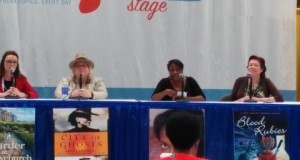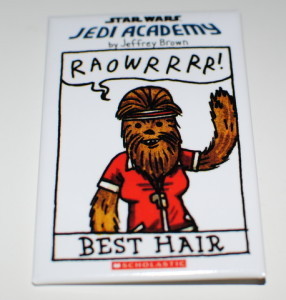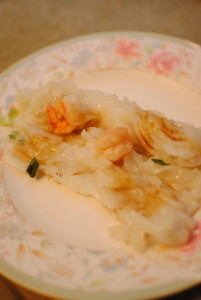Jennifer J. Chow's Blog, page 61
July 21, 2014
Mystery Writing Tips (ALAAC 2014 part 3)
“When the rabbits are dead, the hounds that tracked them will be cooked.” –Chinese proverb
A new crime every time–that’s the vital essence of a thriving mystery series. At the ALA conference in June, I saw a panel of women mystery authors. The group consisted of Hannah Dennison (MURDER AT HONEYCHURCH HALL, “Downton Abbey meets Midsomer Murders“), Kelli Stanley (CITY OF SECRETS, “a noir tale of high order”), Rachel Howzell Hall (LAND OF SHADOWS, “hard-hitting tale of a modern, complex Los Angeles”), and Jane K. Cleland (BLOOD RUBIES, “combination of antiques expertise and ingenious detection”).
Here are some of the topics they discussed:
Getting In
They all had different avenues of getting their first debut novel published. This varied from a straightforward query letter (Stanley) to connections through a writing program (Dennison). It’s encouraging that there are many ways of getting your foot in the door!
Critique Groups
Interestingly enough, none of them currently were involved in a writing group. Some had tried it in the past, while others had eschewed them entirely. All of them wrote the first draft in a bubble, and then they self-edited, received criticism from a close partner, or worked with a professional editor.
Schedules
Most of the women followed a schedule, some more rigid than others. A few of them held other day jobs and/or reared children, so they needed to carve out the time. “Plant your butt down and write” seemed to be the main advice.
Plotters & Pantsers
Writing style also varied across the board. Some women liked to write from a detailed outline; although one admitted that it was boring to follow point-to-point, so she liked to embellish and throw in some dead bodies along the way. Others used an organic process, writing from a deep knowledge of the protagonist.
Research
Everyone seemed to dabble in research, either for a specific setting (LA for Howzell Hall) or time period (1940s for Stanley) or for a character’s expertise (Cleland for her Josie Prescott Antiques mysteries). Research also added to the unique tone of stories, like in Dennison’s cozy mysteries with quirky British traditions (Vicky Hill mysteries).
This is my last ALA recap post. Thanks for reviving memories with me!
July 18, 2014
Foodie Friday: Char Kuey Teow
Char kuey teow: stir-fried flat noodles, Malaysian-style
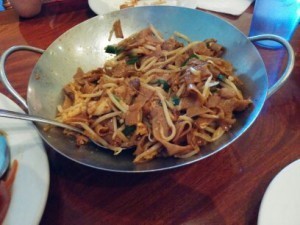 This is chow fun, elevated. Most popular in Malaysia and Singapore and eaten off the carts there, it’s essential hawker food. In the past, char kuey teow was served by low-income workers (like fishermen) who increased their salaries by selling the dish in the evenings.
This is chow fun, elevated. Most popular in Malaysia and Singapore and eaten off the carts there, it’s essential hawker food. In the past, char kuey teow was served by low-income workers (like fishermen) who increased their salaries by selling the dish in the evenings.
Proper char kuey teow offers a smoky flavor from the flames of the wok. It’s also got a unique coloring through a mix of light and dark soy sauce. Oftentimes prawns dot the surface (don’t forget that Malaysia is near the water, so fresh seafood is a must). A splash of belacan, that spiced-up shrimp paste, makes the dish ready to go. Here’s a full recipe for those wanting to experiment in the kitchen.
What’s your favorite noodle dish?
July 14, 2014
Author Celebrity Sightings (ALAAC 2014 part 2)
“Spilt water cannot be retrieved.” –Chinese proverb
Words spilled out as writers can’t be retrieved. Words said as admirers can’t be taken back either, which I found out while blubbering to my favorite authors at the ALA conference. (Okay, so I wasn’t crying, but I still wasn’t suave.)
Here are my celebrity shots:
Jean Kwok
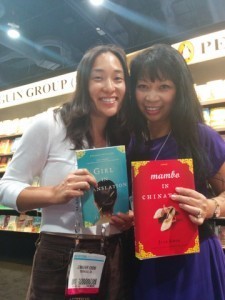
One of my favorite Asian American writers, we share a Hong Kong connection (my mom’s from there). Jean was the first well-known author (think NYT bestseller) to support me. When I was struggling with my writing career, she encouraged me through Twitter to follow my dreams. I also love that her book, Girl in Translation, unravels the untold world of sweatshop workers.
Hannah Dennison

I met Hannah through a UCLA Extension writing class. Actually, I was pretty at ease speaking with her, and she congratulated me on my finalist standing with Foreword Reviews. It was all smooth…until the kids starting crawling around the floor and picking up the confetti stars decorating the carpet. Hannah’s first mystery series (Vicky Hill) features an obituary reporter as the protagonist. She adds fun to her England-based mysteries by incorporating quirky local traditions, like snail racing and hedge jumping.
Markus Zusak
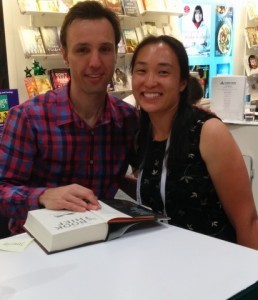
I waited an hour in line to speak with him and then I rambled on about how I loved his writing. I also mentioned that I had a French friend who was a big fan as well (that was for you, Evelyne!). I’m not sure how much he understood, since I was rapidly speaking in American English (Markus, by the way, has a charming Australian accent). He, if you don’t already know, is the talented author of The Book Thief, a tale of Nazi Germany told using Death as the narrator.
Come back next Monday when I will explore mystery writing tips in part 3, the last installment of my ALAAC posts!
July 11, 2014
Foodie Friday First: Uni Don
My first…
Uni don: sea urchin rice bowl
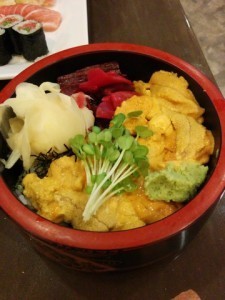
(Uni is the orange slices filling up half the bowl.)
Okay, I admit it. I had no idea going into the restaurant what uni actually was. The dish rated highly on the Yelp reviews, though, so I thought I’d give it a try. Imagine my surprise when I found out that it was actually sea urchin, those prickly creatures I’ve touched in the local tidepools.
Despite its needle-y appearance, the inside of a sea urchin is soft and delicate. The strands of uni have almost a slimy consistency. It’s also got a powerful mixture of flavor; a sea freshness combined with a heady floral taste. It reminded me of eating rose-flavored candies.
I hear it’s an acquired taste, so while I wasn’t overly enthralled by sea urchin, I think it was interesting and unique to try out.
Anything new you’ve tried out lately?
July 7, 2014
Solace through Swag (ALAAC 2014 part 1)
“If the horse dies, then you have to walk.” –Chinese proverb
You ride pretty high until the horse falters and you fall off. What else can you do then but walk?
I went to the American Library Association Annual Conference (ALAAC) at the end of June to listen to the award announcements for Foreword Reviews’ Book of the Year. The bad news: I didn’t place in the top four slots in the multicultural category. The good news: I’m still a bonafide finalist!
Another silver lining is that I got a free pass to the exhibits hall for the weekend. I decided to drown my disappointment by collecting swag. Librarians have it made because they get free advanced reader copies, which meant that I left the conference with 16 new books to read at my leisure.
They also receive other great freebies. Here’s a list of the favorite items I picked up:

Apple stress ball (Rainbow Book Company)
Bean seeds (A BEAN, A STALK, AND A BOY NAMED JACK by William Joyce and Kenny Callicutt)
Bejeweled mug (“Great stories shine.” Thomas Nelson)
Growth chart (YOU ARE (NOT) SMALL by Chris Weyant and Anna Kang)
Hair clip with bookmark (DYED AND GONE by Beth Yarnall)
Luggage tag (FLIGHT SCHOOL by Lita Judge)
Magnet set (WHY WE BROKE UP by Daniel Handler and Maira Kalman)
Orange feather boa (tutor.com; online tutoring site)
Star Wars pin (STAR WARS: JEDI ACADEMY by Jeffrey Brown)
World map (Scholastic)
All the cute stuff made me feel better! And here’s a picture of the pin because words won’t do it justice:
Visit my blog next Monday for part 2 of the conference recap, featuring celebrity author sightings!
July 4, 2014
Foodie Friday: Ube Cake
Ube cake: chiffon cake made with purple yams

I really love this bright violet color! It cheers me up whenever I see it. This is a light cake that really gives you the yummy yam flavor (that’s if you like root vegetables, though). On a side note, I tend to confuse taro with ube (sorry, Filipino friends), but now I stand corrected:
Taro
usually white, or maybe a light purple
poisonous if eaten raw
called “elephant ears”
Ube
dark purple in color
grows on vine above ground
not as typical in US (but you can find the powder in frozen sections of Asian markets)
June 30, 2014
My Writing Process Blog Tour
“If you do not climb the mountain, you will not see the plain.” –Chinese proverb
Writing is a process, an arduous climb to the top to reach the magnificent peak. Thank goodness I’m not alone in this journey. One friend is fellow Wordsmith Studio writer, Julia Tomiak, who masters vocabulary words on her blog. She recently tagged me for a writing process blog tour, where I get to answer these three questions:
What am I working on?
I’ve completed a cozy mystery about an ex video game tester turned detective. It’s making the query rounds (wish me luck!). In the meantime, I’m crafting a YA story because I like keeping busy.
Why do I write what I do?
My tagline is “Asian American fiction with a geriatric twist.” I love combining my identities (Chinese American and past geriatric social worker) into my writing. I feel like there’s so much to explore in those two worlds. Along the way, I hope to enlighten others (and myself sometimes!).
How does my writing process work?
I squeeze it in while taking care of my kids, but I prefer writing at regular times (after their bedtime works pretty well). I’ve used both typing and longhand to create stories. My current manuscript is being written by hand; somehow that helps me to be freer with world building.
Before I start writing, I do a lot of research and have a general outline of what things will happen. Sometimes I’ll also sketch character profiles. When I get down to putting pen on paper, I often have the pivotal scenes envisioned in my mind.
For the whole manuscript process, I write the rough draft alone, leaving it to fester for several weeks, and then revise it multiple times. After that I launch it to my writers’ group and beta readers to see how it fares and correct based upon their suggestions.
Meet Jessica Schaub
Now I’m tagging Jessica Schaub, a fellow Martin Sisters Publishing author. She wrote a book called Unforgettable Roads, which delves into family relationships. Among other characters, it has an older grandfather who’s suffering from Alzheimer’s. It’s a beautiful story about faith and values, that also features a little mystery to unravel.
June 27, 2014
Foodie Friday: Ha Cheong
Ha Cheong: ubiquitous dim sum dish made of steamed rice rolls and shrimp
There’s a slew of rice noodle rolls to select from on the dim sum cart: beef, dried shrimp with scallions, char siu, etc. My favorite is the simple style with tasty prawns. The key is having fresh shellfish coupled with a tender steamed wrapper–the texture of the skin should be almost too slippery for your chopsticks to hold. Of course, the highlight of ha cheong has to be the sweet soy sauce (some versions call for rock sugar to be simmered in water). Shrimp rolls are a quick and easy eat; oftentimes, I’ve used it for a fast meal. They can also double for enjoyment on special occasions, though, like our recent yum cha (“drinking tea” in Cantonese) venture this past Father’s Day.
June 23, 2014
ALA, Here I Come!
“Trees may prefer calm, but the wind will not subside.” –Chinese proverb
The wind’s been blowing me here and there. In fact, this post is a little late because I had to prepare for a book talk. I interacted with teens at the local library today, talking about the process of writing and encouraging them to complete their own works over the summer. It’s amazing to see their passions and their diverse interests, which can range from manga to poetry.
 Speaking of libraries, I’m gearing to attend the ALA (American Library Association) Conference! It’ll be exciting to see what I discover during my whirlwind trip to Las Vegas. Here are some of the highlights I’m looking forward to:
Speaking of libraries, I’m gearing to attend the ALA (American Library Association) Conference! It’ll be exciting to see what I discover during my whirlwind trip to Las Vegas. Here are some of the highlights I’m looking forward to:
Announcement of winners for Book of the Year Award (currently I’m a finalist, so it’ll be narrowed down to the top three this Friday evening)
Sighting famous authors (I’m looking forward to spotting Marcus Zusak, Jean Kwok, Mo Willems, and more over the weekend)
Meeting with librarian friends (got to love those library science majors!)
June 20, 2014
Foodie Friday: Oxtail Soup
Oxtail soup: savory broth made with the tender, fatty meat
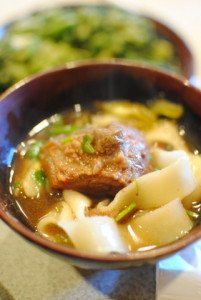 This tender meat falls right off the bone, particularly after hours of stewing. It also infuses a very hearty flavor into the broth. It’s a bit of work to eat around the large bone in the center, though. I’m disappointed to learn that the meat does not come from an ox (a great Chinese zodiac symbol)–it used to, but nowadays, the cuts are from cattle.
This tender meat falls right off the bone, particularly after hours of stewing. It also infuses a very hearty flavor into the broth. It’s a bit of work to eat around the large bone in the center, though. I’m disappointed to learn that the meat does not come from an ox (a great Chinese zodiac symbol)–it used to, but nowadays, the cuts are from cattle.
My favorite facts about oxtail:
Origins: A French noble asked for a tail from the local slaughterhouse and created the soup; in America, African-American slaves would “make do” with leavings and cooked oxtails
Poorer folks used to eat it because of the high fat content and long cooking time
The Korean version, kkori gomtang, is a delicacy; chefs can pay the equivalent of $100+ for one single oxtail
Try your hand at oxtail soup!

